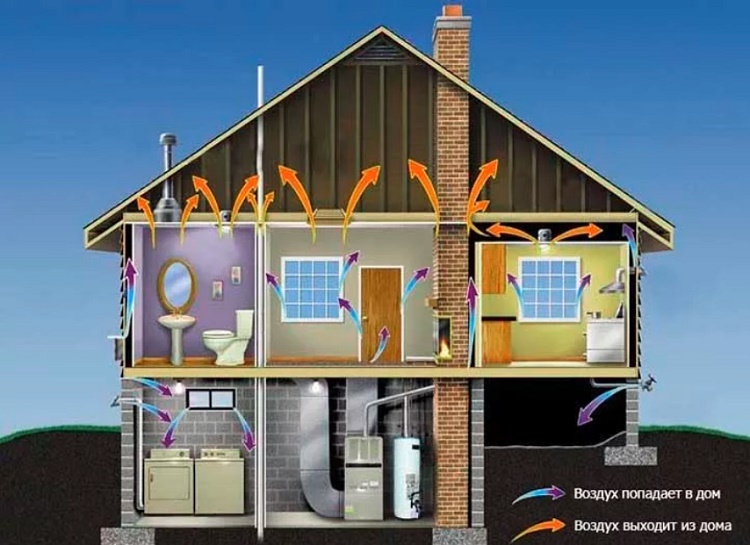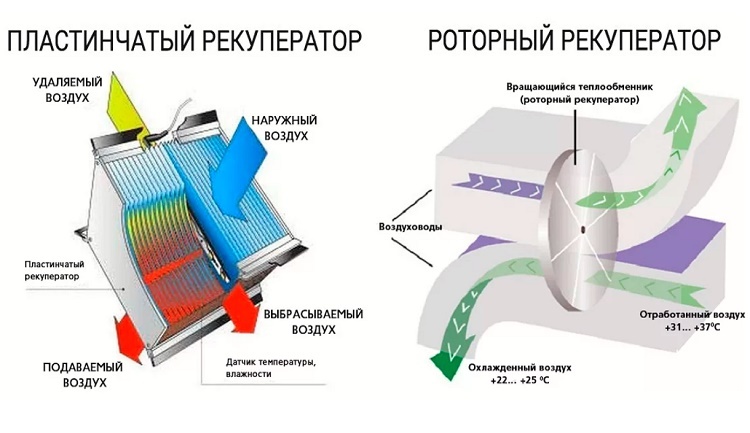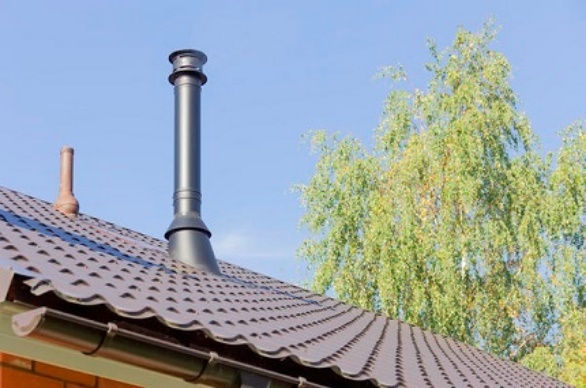The bathroom is one of those places in the apartment that simply needs high-quality ventilation. With its help, excess moisture, which appeared after taking a shower, and specific aromas of cosmetics or detergents go into the mine. Maintaining an optimal microclimate prevents the formation of mold or mildew, condensation on the mixer, mirrors or pipes, the gradual destruction of finishing materials and damage to furniture.
But natural ventilation is not always effective, is it? Therefore, installing a forced exhaust system sometimes it turns out to be the only way to eliminate steam and unwanted odors from the bathroom. However, long-term operation of the fan will inevitably lead to contamination of its components and a gradual decrease in performance. To improve the performance of the device, you need to know how to disassemble the exhaust fan, properly clean its parts and re-install.
In this material, we will consider the structure of the hood, its step-by-step analysis, we will tell you how to quickly wash the appliance, mentioning why the draft in the bathroom can decrease even with a properly working exhaust appliance.
The content of the article:
- The structure and principle of operation of the hood
-
Subtleties of disassembling and cleaning the hood
- Step # 1 - unplug and remove the hood
- Step # 2 - disassembly and maintenance
- Step # 3 - reassembling and installing the appliance
-
Typical causes of reduced thrust
- Reason # 1 - violation of air exchange
- Reason # 2 - clogged ventilation ducts
- Reason # 3 - installation by neighbors of powerful hoods
- Reason # 4 - the presence of a check valve
- Conclusions and useful video on the topic
The structure and principle of operation of the hood
In order to correctly disassemble and wash the hood in the bathroom, you should familiarize yourself with how it works and works. Most common models for installation in the bathroom are axial (axial) fans, which are mounted on the wall in the place where the ventilation duct passes.
The axial hood has an extremely simple device. The device captures air by rotating the axis on which the aerodynamic impeller with blades is fixed. Behind it is a compact motor, thanks to which the axle moves.
The impeller blades have a certain inclination. It causes the passage of air through the fan system, partially prevents the re-entrainment of the waste stream and promotes the formation of pressure, which entrains air into the ventilation duct.
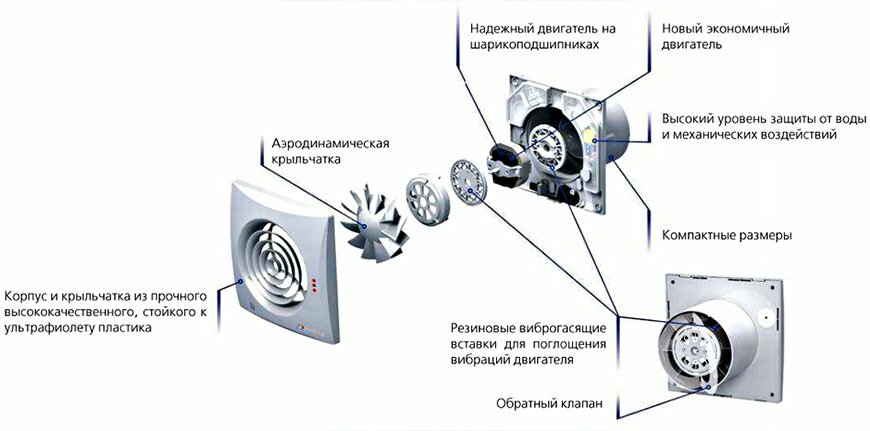
But even such a simple device is capable of effectively purifying the air from steam and unwanted impurities. It is only important to monitor the cleanliness of the device and the presence of the necessary traction.
It is the fan blades that are most sensitive to pollution, since most of the dust and smoke particles settle on them if you smoke in the room.
The place where the impeller is attached to the axle also needs to be thoroughly cleaned. In addition to removing debris, this area must be periodically lubricated. A couple of drops of special oil will be needed for the front and rear bearings, which are located near the motor.
The fact that it is time to dismantle and rinse the hood can be understood by visual inspection by shining a flashlight behind the outer grill.
The following signals may also indicate the need for cleansing:
- increase in noise levelgenerated by the fan during operation;
- reduced thrust due to a drop in the performance of the hood.
All these facts indicate that the rotation speed of the aerodynamic impeller has dropped, so the hood needs to be disassembled, routinely cleaned and diagnosed with possible malfunctions.
Subtleties of disassembling and cleaning the hood
In order to dismantle the hood, it is not necessary to invite a specialist. First, you need to find in the user manual the item on how to remove the front cover of the fan in bathroom, and after studying the instructions, proceed with the subsequent disassembly and self-service devices.
Step # 1 - unplug and remove the hood
Removal of the device begins with de-energizing the line from which the hood is powered. This is especially important if the fan is directly connected to the light switch and begins its work at the same time as the light source in the bathroom.
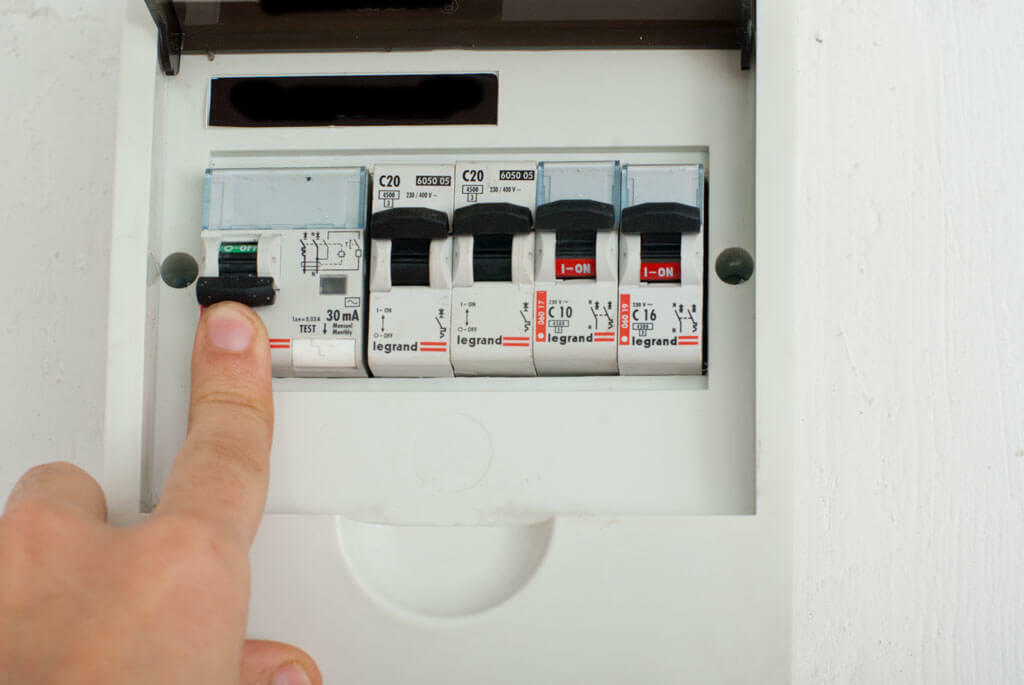
If a separate automatic machine is not provided for the bathroom network, you will have to disconnect the entire apartment from the electricity. To avoid such inconveniences, when replacing intra-apartment electrical networks and installing a shield, it is worth bringing out individual machines for each room.
The hood cover itself is often attached to several self-tapping screws, which are placed at the end of the case for aesthetics of the design. Less often, it can be equipped with grooves, with which it is fixed.
After removing the cover, there are several steps to follow:
- Unscrew the self-tapping screws that fix the device in the ventilation holes.
- Pry the housing around the perimeter, detaching it from the wall if it was glued.
- Carefully take out the device and disconnect its wires from the mains cable.
If the hood was in operation before dismantling, it is necessary to let it cool down, after which the fan can be disassembled.
Step # 2 - disassembly and maintenance
After the fan has cooled down, the main components must be carefully disassembled in order to clean and lubricate the necessary parts.
To do this, you have to perform the following steps:
- Remove the impeller wheel. Most often, it is attached to the shaft using the collet method. To detach a part, you just need to turn the fastening nut.
- Carefully remove the motor by first disconnecting the terminals. The motor itself is usually attached to the housing with two screws.
After that, you can start cleaning the parts and lubricating certain units with machine oil: bearings, axles. It is best to brush off dust from areas that cannot be washed with a soft, medium-sized brush.

In addition to cleaning the hood itself, you should pay attention to the ventilation shaft. If possible, remove dirt at the entrance to the ventilation duct using a vacuum cleaner and a damp cloth
The fan impeller, outer cover and insect screen from the shaft must be thoroughly rinsed with water. It is advisable not to use detergents, as they can be quite aggressive towards plastic.
The best cleaning agent is regular laundry soap without bleaches. It produces abundant dense foam, which can effectively remove dirt deposits from the hood parts.
Then you have to lubricate the main units of the hood. A syringe with a fine needle is most convenient for spot lubrication. Turn the swivel parts to distribute the oil evenly.
Before proceeding with the installation again, you must thoroughly dry all the components and remove excess oil by blotting the desired areas with a napkin.
Step # 3 - reassembling and installing the appliance
The hood assembly also does not require a lot of knowledge. Next, we will analyze how to reassemble the built-in fan in the wall after we managed to clean it.
Restoring structural integrity includes several key points:
- installation of the motor in the case with the subsequent connection of the terminals;
- fixing the aerodynamic impeller on the axis.
You need to be especially careful about fixing the impeller: if you install it with the back side, you can provoke the appearance of a reverse draft, due to which the polluted humid air will not leave bathroom.
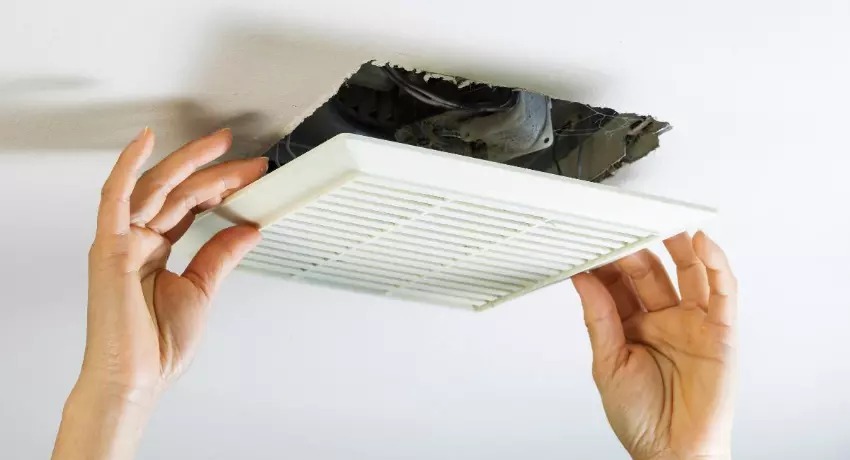
Installation of the outer grille cover of the hood is carried out after the final installation of the device directly into the hole leading to the ventilation shaft
All the information you need to know about fan installation contained in the instructions for the device.
Usually, after assembling the main part of the structure, the user needs to:
- grease the back of the case with glue like "Liquid nails";
- place the hood in the hole made in the shaft;
- fasten all self-tapping screws around the perimeter of the case;
- connect the power wires;
- install a mosquito net;
- fix the hood cover with bolts if there are no grooves in the structure.
After installation, you need to make sure that the device is working - check it for switching on and the ability to create sufficient thrust.
Typical causes of reduced thrust
If, after you have managed to wash the hood in the bathroom, its performance has not increased to the nominal, it is worth identifying the reasons why the device is defective.
In addition to normal wear and tear, the suction level can be influenced by many different factors. But more often than not, the root of insufficient air exchange lies in a decrease in traction. So why is it that a properly functioning and clean forced draft hood does not cope with the removal of humid air?
Reason # 1 - violation of air exchange
The wall-mounted hood requires a supply of fresh air to suck out the air currents. To do this, at the bottom of the door there should be special holes with gratings through which air from other rooms will enter the bathroom.
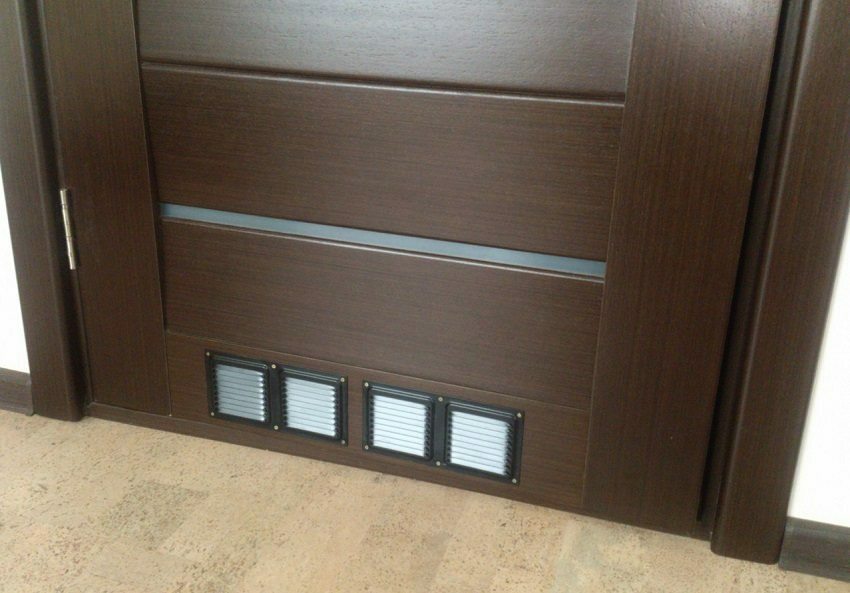
Doors with ventilation grilles are aesthetically pleasing to the interior. To ensure the flow of air, it is enough to choose a leaf with three to five holes located at the bottom of the door
If there is no opportunity and desire to replace the interior door, it is worth leaving it ajar more often, expand the opening between the door leaf and the door frame or cut through the ventilation holes.
Installation of plastic windows, thorough insulation of the walls and reliable entrance doors with good insulation significantly prevent the penetration of street air into the house. Therefore, even in winter, it is important to periodically ventilate all rooms. And also put windows with supply valve.
Reason # 2 - clogged ventilation ducts
If the ventilation shaft is clogged with dirt or blocked, even a powerful forced draft hood will not cope with its tasks. Therefore, it is necessary to check the presence of natural ventilation. If the built-in hood does not have a check valve, this can be done in the simplest way. Such testing can be carried out in the cold season, since in summer, when the air temperature in the room and outside is too high, a sufficient pressure drop will not be created.
After turning off the fan, ensure the flow of fresh air by opening the apartment windows and the door to the bathroom. Lean a napkin against the grill of the hood. If a piece of lightweight paper is attracted to the hole, then everything is in order with the functioning of the ventilation. And if there is no draft at all, you need to contact the management company, after which a special service will check the ventilation ducts and perform them cleaning.
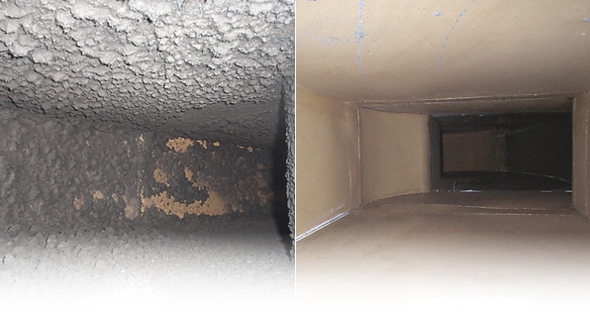
The difference between a polluted and a cleaned ventilation shaft is clearly shown in the photo. However, for such a thorough cleaning, special equipment will be required, so calling specialists cannot be avoided.
Additionally, you can determine the presence of traction by the condensation that falls on the mirror after taking a bath. If the steam quickly disappears after opening the doors to the room, then the natural ventilation is functioning properly.
Reason # 3 - installation by neighbors of powerful hoods
If the neighbors living on the floors below install too powerful fans, the draft in the duct can drop significantly due to the formation of a rapid air flow. In some cases, a phenomenon may occur reverse thrustin which air from the bathrooms of other residents will be blown into the rooms on the floors above.
To get rid of these problems, it is worth either negotiating with neighbors, or installing a more powerful forced air removal device.
However, the latter option is fraught with inconvenience for the residents above and may require widening the hole in the wall leading into the shaft. This is due to the fact that the diameter of the duct inlet also affects the rated performance of the exhaust fan.
Reason # 4 - the presence of a check valve
To prevent unpleasant odors from the neighbors below from entering the bathroom, users often supplement the design of the wall exhaust system with a special detail - check valve. It cuts off air flows from the ventilation duct.
But in the absence of a normal inflow and the installation of an unsuitable exhaust hood, it will completely block the air duct, thereby depriving the room of a natural way to extract air
Conclusions and useful video on the topic
The detailed process of removing the hood cover and the amount of dirt deposited on the parts is filmed by the author of the video below:
The author of the following video tells how to properly install the hood on the wall in the bathroom if the hole leading to the ventilation duct is much larger than the diameter of the fan inlet:
Detailed disassembly and repair of the hood has been demonstrated by another author:
A properly working hood in the bathroom is a guarantee of maintaining a normal microclimate throughout the home, since the presence of excess moisture in one room will inevitably affect the general level of humidity in the apartment.
Like any other device, an exhaust fan needs periodic maintenance and cleaning. Dismantling, disassembling, cleaning and reinstalling the wall-mounted hood does not take much time and does not require special knowledge. However, if, after completing the planned procedures, the fan still does not provide proper air exchange, you should pay attention to the correct functioning of natural ventilation.
Have you recently disassembled the fan and cleaned it from dirt? Share your experience with other users, tell us which part of the work turned out to be the most difficult for you. If you still have questions on the topic of the article, ask our experts - the feedback form is located below.
